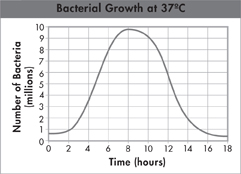Standardized Test Prep
Multiple Choice
A type of virus that infects bacterial cells is called a
capsid.
prion.
bacteriophage.
retrovirus.
Prokaryotic cells that have a spherical shape are called
cocci.
methanogens.
spirilli.
bacilli.
What is a capsid?
viral DNA that inserts into a host's DNA
a protein coat surrounding a virus
a type of plant virus
a rod-shaped bacterium
Which of the following is NOT used to identify specific prokaryotes?
type of nucleic acid
shape
movement
energy source
Which method is NOT used to protect food against microorganisms?
heating
freezing
sterilization
vaccination
Which illness is caused by a bacterium?
AIDS
polio
diphtheria
common cold
Which process is used for the exchange of genetic information between two bacterial cells?
endospore formation
lysogenic cycle
conjugation
binary fission
All bacteria are classified as
eukaryotes.
protists.
archaea.
prokaryotes.
Questions 9–10
Use the graph below to answer the questions.
At which interval in the graph does the number of living bacteria increase at the greatest rate?
between hours 2 and 4
between hours 4 and 6
between hours 6 and 8
between hours 10 and 12
Which is the most likely reason for the decrease in bacteria shown?
The temperature of the bacterial culture was too high after 8 hours.
The bacteria stopped reproducing after 8 hours.
More nutrients were added to the culture at regular intervals.
Waste products from the bacteria accumulated in the nutrient solution.
Open-Ended Response
Explain why antibiotics can be useful in treating bacterial diseases but not in treating viral diseases.
| Question | 1 | 2 | 3 | 4 | 5 | 6 | 7 | 8 | 9 | 10 | 11 |
|---|---|---|---|---|---|---|---|---|---|---|---|
| See Lesson | 20.1 | 20.2 | 20.1 | 20.2 | 20.3 | 20.3 | 20.2 | 20.2 | 20.2 | 20.2 | 20.3 |
Table of Contents
- Formulas and Equations
- Applying Formulas and Equations
- Mean, Median, and Mode
- Estimation
- Using Measurements in Calculations
- Effects of Measurement Errors
- Accuracy
- Precision
- Comparing Accuracy and Precision
- Significant Figures
- Calculating With Significant Figures
- Scientific Notation
- Calculating With Scientific Notation
- Dimensional Analysis
- Applying Dimensional Analysis





